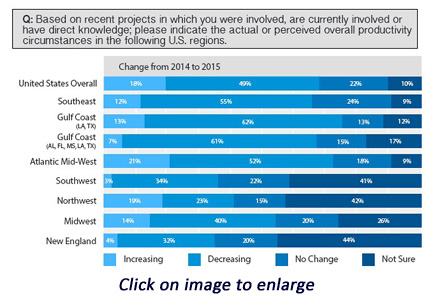Compared to other industries, construction productivity has declined significantly. Hear directly from owners on how to improve productivity. The CLMA (Construction Labor Market Analyzer) white paper, Construction Productivity in an Imbalanced Labor Market highlights the construction labor productivity challenge as a major issue due to declining skill levels and labor shortages. One reason identified for poor productivity includes the fact that construction methods have not changed in decades and the industry has shown a marked reluctance to embrace new approaches such as lean manufacturing techniques.
The CLMA (Construction Labor Market Analyzer) white paper, Construction Productivity in an Imbalanced Labor Market highlights the construction labor productivity challenge as a major issue due to declining skill levels and labor shortages. One reason identified for poor productivity includes the fact that construction methods have not changed in decades and the industry has shown a marked reluctance to embrace new approaches such as lean manufacturing techniques.
The Need to Buck Current Productivity Trends
The chart on page 13 of the report (also shown above) shows regional changes in labor productivity as reported by owners and contractors. Overall, 49% felt that productivity was declining, with the worst areas including the Gulf Coast, the Southeast and the Atlantic Midwest while areas such as the Northwest appear to be bucking these trends. Although construction levels are lower in the Northwest, as construction activity escalates there, it’s likely that productivity challenges will become more pronounced. If owners want to avoid project delays and overruns, it's essential that productivity decline is arrested.
What Can Owners Do?
Owners need not be silent partners nor accept the inevitability of delay. They can influence this trend by insisting that contractors adopt labor practices that contribute to productivity improvement. This has been successful in other industries, and can be done by insisting contractors submit bids committing to achieving certain targets, including:
- The right mix of skills: While recognizing skilled craft workers are in short supply, work teams can be effective if they combine a suitable mix of skills, including apprentices and other less skilled employees under the guidance of skilled craft artisans. This approach helps bridge the skills gap while ensuring work says on track.
- Improved front-end planning: A contributory factor to project delay is late changes to the project scope. Owners should focus on front-end planning, ensure the project scope is fixed and the plan of execution is carefully prepared before requesting bids. They must be careful about modification to the scope during execution because unexpected changes disrupt work flow and cause significant delay. Additionally, planning should be a continual effort, not just at the front-end, where best and worst case scenarios are considered throughout planning and execution so as to anticipate and avoid the kinds of marketplace challenges that can be detrimental to project outcomes.
- Construction techniques: Deliberate emphasis should be placed on improved construction techniques. Although each project is different, careful attention to materials management, the selection of material components that require less labor, and the use of offsite prefabrication reduce avoidable delays, speed up construction while simultaneously reducing the load on skilled artisans.
- Lean construction: Lean manufacturing has revolutionized the industry and restored the competitiveness of American manufacturers. Historically, the construction industry has held back from adopting these techniques in the mistaken belief that they don't apply. Owners should insist on a process of continuous improvement, measurement of work performance, the reduction of waste and the utilization of untapped employee potential.
A Brighter Outlook?
Although these measures may increase the initial bid price and invoke resistance, they will help ensure projects run smoothly and reduce the potential for costly delays and cost overruns. They will attract construction companies that are vested in improving productivity and deter those that are holding to outdated techniques. To find out more about how to improve productivity, download this white paper and invest in construction practices that lead towards improved productivity.


